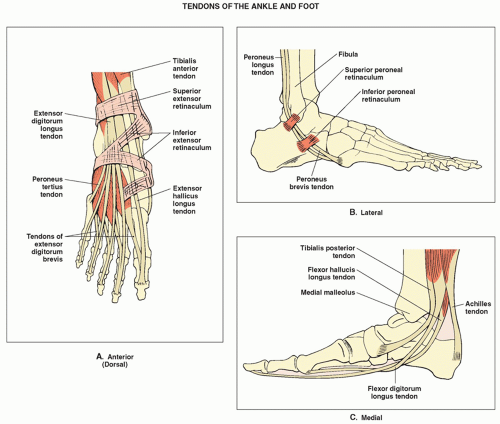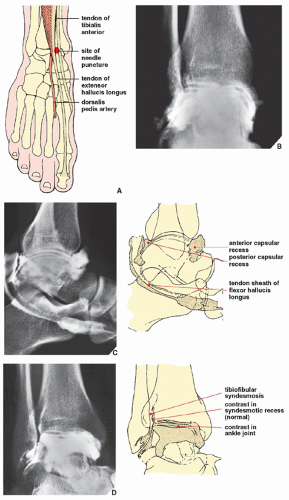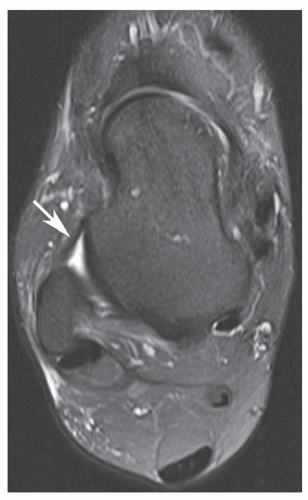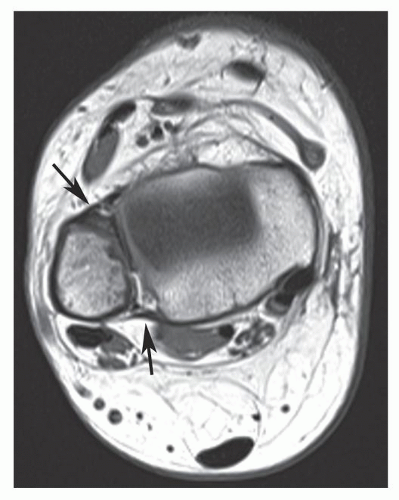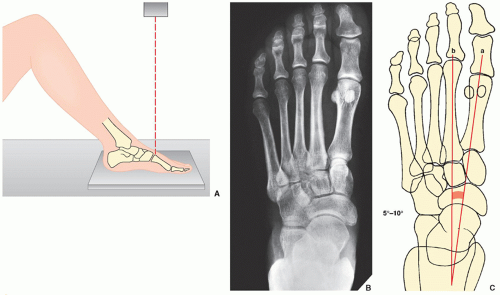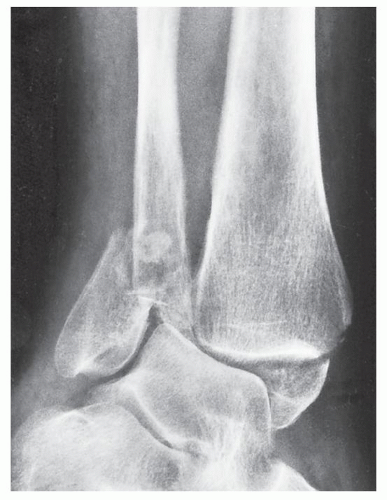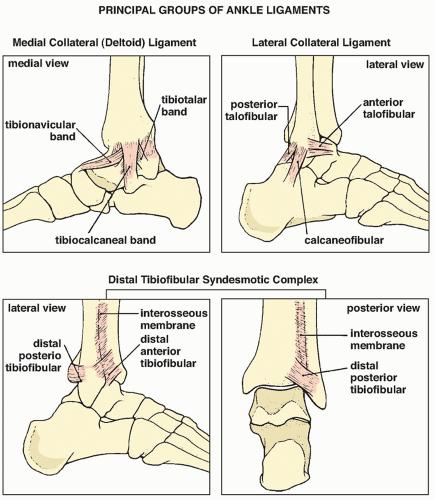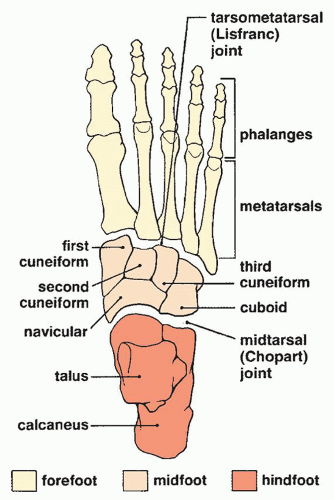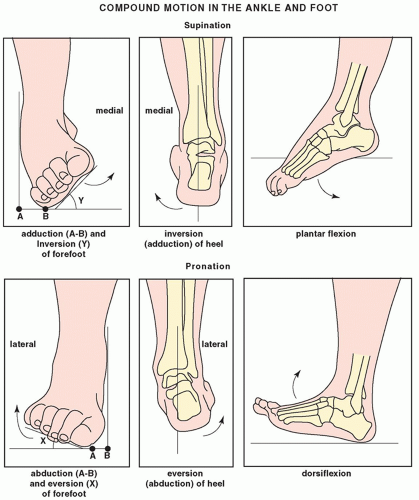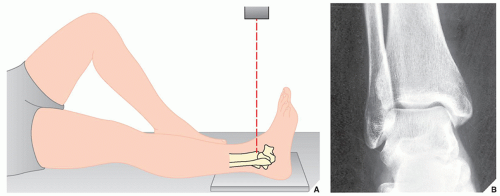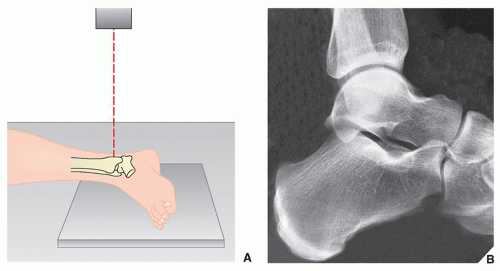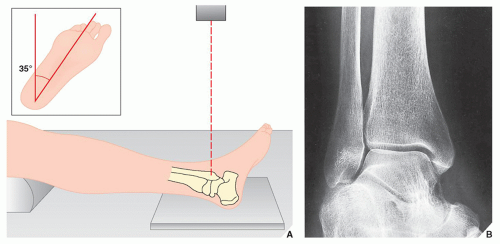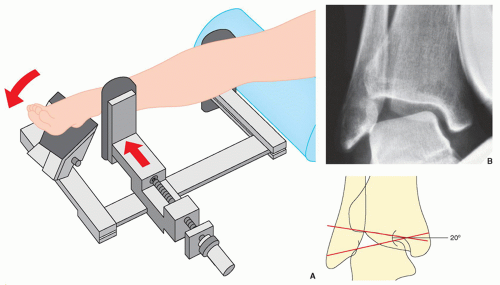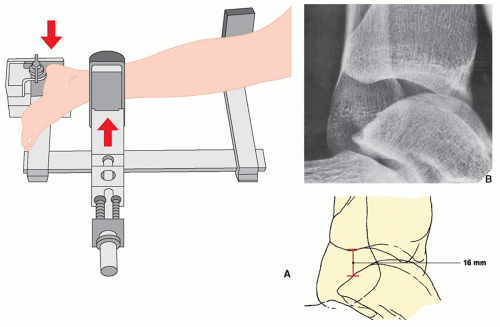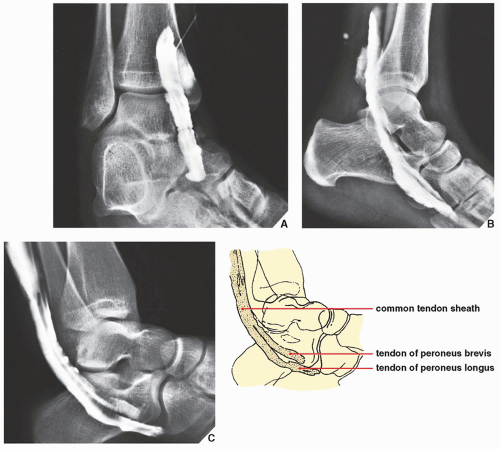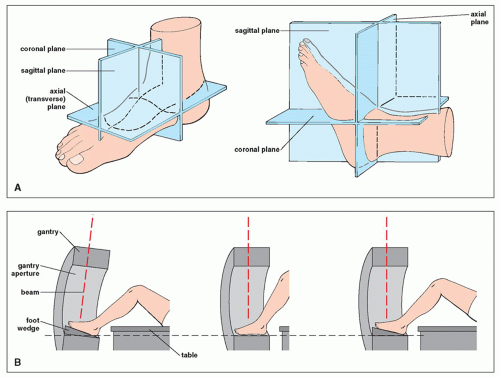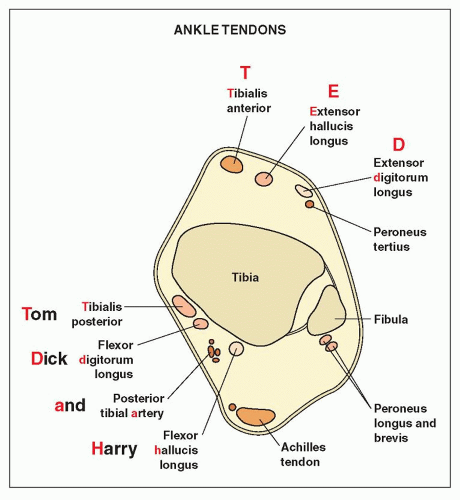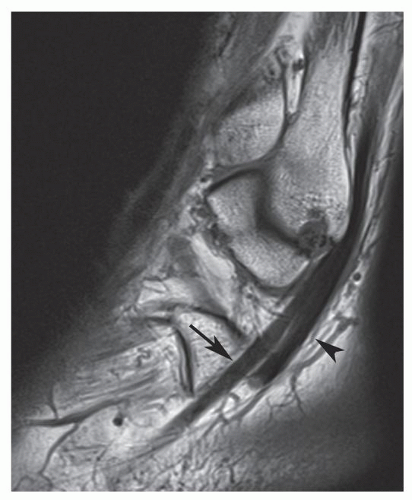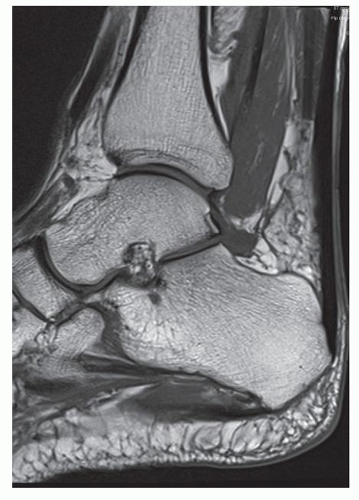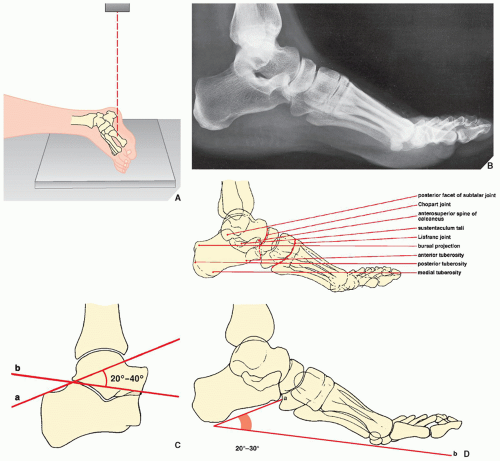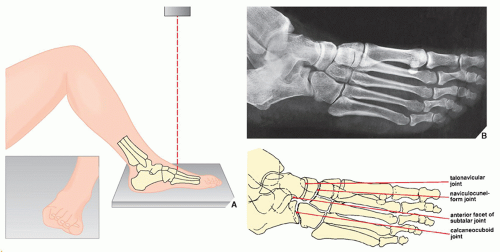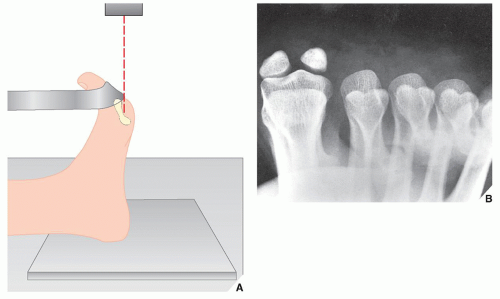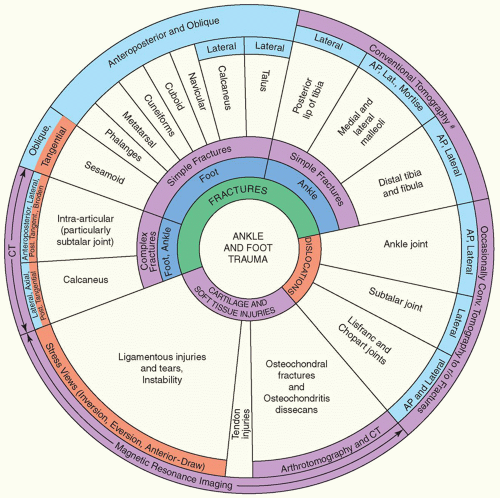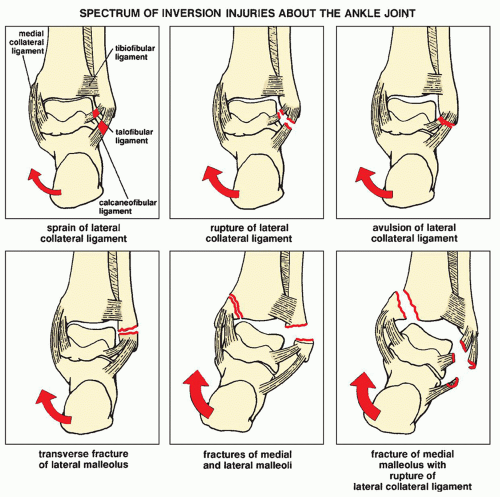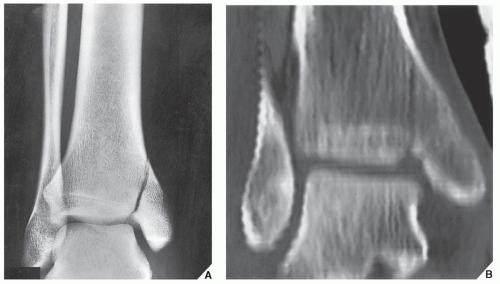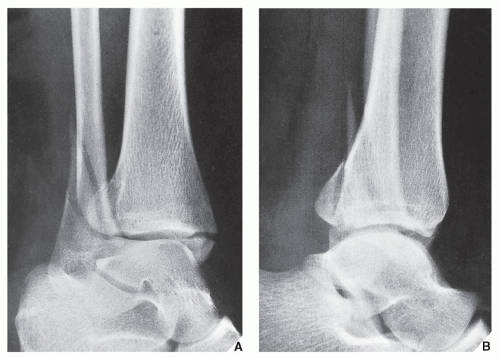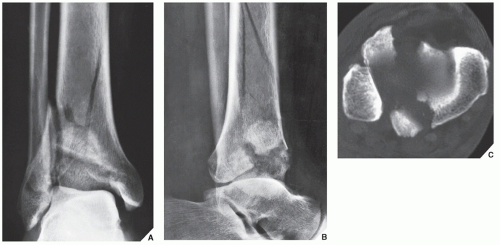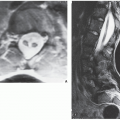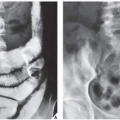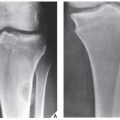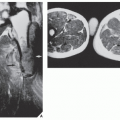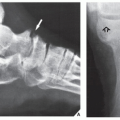Ankle
The standard radiographic examination of the ankle, as a rule, includes the anteroposterior (including the mortise), lateral, and oblique projections. Stress views are also frequently obtained for evaluating ankle injuries. These may also need to be supplemented with special projections.
On the
anteroposterior view, the distal tibia and fibula, including the medial and lateral malleoli, are well demonstrated (
Fig. 10.5). On this projection, it is important to note that the fibular (lateral) malleolus is longer than the tibial (medial) malleolus. This anatomic feature, important for maintaining ankle stability, is crucial for reconstruction of the fractured ankle joint. Even minimal displacement or shortening of the lateral malleolus allows lateral talar shift to occur and may cause incongruity in the ankle joint, possibly leading to posttraumatic arthritis. A variant of the anteroposterior projection, in which the ankle is internally rotated 10 degrees, is called the
mortise view because the ankle mortise is well demonstrated on it (
Fig. 10.6).
The
lateral view is used to evaluate the anterior aspect of the distal tibia and the posterior lip of this bone (the so-called
third malleolus) (
Fig. 10.7). Some fractures oriented in the coronal plane can be better visualized on this projection. Ankle joint effusion can also be assessed on this view (see
Fig. 10.65).
The
oblique view of the ankle, best obtained with the foot internally rotated approximately 30 to 35 degrees, is effective in demonstrating the tibiofibular syndesmosis and the talofibular joint (
Fig. 10.8). An
external oblique view may also be required to evaluate the lateral malleolus and the anterior tibial tubercle (
Fig. 10.9).
Most ankle ligament injuries require stress radiography, ankle joint arthrography, computed tomography (CT), or magnetic resonance imaging (MRI) (see later) for demonstration and sufficient evaluation. Some, however, can be deduced from the site and extension of fractures on the standard radiographic examination. A thorough knowledge of the skeletal and soft-tissue topographic anatomy of the ankle, together with an understanding of the kinematics and mechanism of ankle injuries, will aid the radiologist in correctly diagnosing traumatic conditions and predicting ligament injuries. With such understanding, the radiologist can even determine the sequence of injury to the various structures.
Some ligament injuries may be diagnosed on the basis of disruption of the ankle mortise and displacement of the talus; others can be deduced from the appearance of fractured bones. For example, fibular fracture above the level of the ankle joint indicates that the distal anterior tibiofibular ligament is torn. Fracture of the fibula above its anterior tubercle strongly suggests that the tibiofibular syndesmosis is completely disrupted. Fracture of the fibula above the level of the ankle joint without accompanying fracture of the medial malleolus indicates rupture of the deltoid ligament. Transverse fracture of the medial malleolus indicates that the deltoid ligament is intact. High fracture of the fibula associated with a fracture of the medial malleolus or tear of the tibiofibular ligament, the
so-called
Maisonneuve fracture (see later), indicates rupture of the interosseous membrane up to the level of the fibular fracture.
When radiographs of the ankle are normal, however, stress views are extremely important in evaluating ligament injuries (see
Fig. 4.5). Inversion (adduction) and anterior-draw stress films are most frequently obtained; only rarely is an eversion (abduction)-stress examination required.
On the
inversion-stress film, obtained in the anteroposterior projection, the degree of talar tilt can be measured by the angle formed by lines drawn along the tibial plafond and the dome of the talus (
Fig. 10.10). This angle helps diagnose tears of the lateral collateral ligament. However, the wide range of normal values for these measurements may make interpretation difficult, and thus comparison studies of the contralateral ankle should be obtained. Even this method is not always accurate; up to 25 degrees of talar tilt has been reported in people with no history of injury, and occasionally, there will be a patient whose ankles exhibit considerable variation in measurement. Many authorities advise that with forced inversion, tilt less than 5 degrees is normal,
5 to 15 degrees may be normal or abnormal, 15 to 25 degrees strongly suggests ligament injury, and more than 25 degrees is always abnormal. With forced eversion, talar tilting of more than 10 degrees is probably pathologic.
The
anterior-draw stress film, obtained in the lateral projection, provides a useful measurement for determining injury to the anterior talofibular ligament (
Fig. 10.11). Values of up to 5 mm of separation between the talus and the distal tibia are considered normal; values between 5 and 10 mm may be normal or abnormal, and the opposite ankle should be stressed for comparison. Values above 10 mm always indicate abnormality.
Ancillary imaging techniques are essential to the diagnosis and evaluation of many ankle injuries. CT may be required to determine the position of comminuted fragments in complex fractures, for example, of the distal tibia, talus, and calcaneus. Arthrography (
Fig. 10.12) is occasionally used for assessing the integrity of the ligamentous structures in acute trauma, although recently, it has been almost completely supplanted by MRI. It is still, however, an effective technique for evaluating the articular cartilage and detecting and localizing loose osteocartilaginous bodies. It is also helpful in evaluation of chondral and osteochondral fractures and osteochondritis dissecans, which usually affects the dome of the talus. A singlecontrast study is usually performed to assess the integrity of the ankle ligaments. For evaluating the articular cartilage, a double-contrast study (combining a positive contrast agent and air) is more effective.
Ankle tenography is a useful procedure for evaluating tendon tears, particularly tears of the Achilles tendon, peroneus longus and brevis, tibialis posterior, flexor digitorum longus, and flexor hallucis longus. According to Bleichrodt and colleagues, tenography particularly has proved to be reliable in the diagnosis of injuries of the calcaneofibular ligament, with a sensitivity of 88% and specificity of 87% to 94%. In a procedure similar to that for ankle arthrography, a 22-gauge needle is inserted into the tendon sheath, with the needle tip directed distally, and 15 to 20 mL of contrast medium is injected under fluoroscopic guidance. Radiographs are then obtained in the standard projections (
Fig. 10.13). Tear is indicated by the extravasation of contrast agent from the tendon sheath, abrupt termination of the contrast-filled tendon sheath, or leak of contrast into the adjoining articulations (see
Figs. 10.68,
10.69, and
10.70). Recently, this technique has been completely replaced by MRI (see
Fig. 10.71).
CT is an effective modality to evaluate various ligaments and tendons because the soft-tissue contrast resolution of CT allows the easy differentiation of these structures from surrounding fat. Specifically, tendon injuries including tendinitis, tenosynovitis, and rupture and dislocation of tendons can be effectively diagnosed. The major limitation in evaluating pathologic conditions of tendons with CT is the inability to scan the tendons in the coronal and sagittal planes. Reformation images, while occasionally helpful, suffer from the lack of spatial resolution and require additional examination time.
For adequate CT of the ankle and foot, proper positioning of the leg in the gantry is essential. In addition, because nomenclature for imaging planes of the feet occasionally creates a problem, it is important to recognize that the coronal, sagittal, and axial planes of the ankle and foot are determined the same way as for the body (
Fig. 10.14A). For coronal images, the knees are flexed and the feet are positioned flat against the gantry table. The coronal sections are obtained with the beam directed to the dorsum of the foot. More commonly modified coronal images are obtained by angling the gantry or by using a foot wedge (
Fig. 10.14B). A lateral scanogram helps to establish the degree of necessary gantry tilt. Axial images are obtained with the feet perpendicular to the gantry table, great toes together, and the knees fully extended. The beam is directed parallel to the soles of the feet. Sagittal images are usually generated by using reformation technique, although direct sagittal sections can also be obtained by placing the patient in the lateral decubitus position. Images in all planes are usually acquired using 3- or 5-mm thin contiguous sections. For threedimensional (3D) reconstruction, 1.5- or 2-mm contiguous sections are required, although 5-mm sections with a 3-mm overlap can also be used.
MRI, with its direct multiplanar capabilities and excellent soft-tissue contrast resolution, has proved to be superior to CT for the evaluation of ankle tendons and ligaments. The tendons show uniformly low signal intensity in all spin echo pulse sequences, with the exception of the Achilles tendon and tibialis posterior tendon. These two tendons, on long repetition time (TR) sequences, occasionally show small foci of intermediate signal intensity within their substance, particularly near their insertions to the calcaneal tuberosity and the navicular bone, respectively. From a practical point of view, it is helpful to memorize the location and relationship
of various tendons seen on axial MR image of the ankle by using the mnemonic phrase, “Tom, Dick, and Harry” for the posteromedial aspect, and “TED” for the anterolateral aspect of the ankle (
Fig. 10.15). The ankle ligaments, likewise, demonstrate low signal intensity on MR images, with the exception of the posterior talofibular ligaments, which often appears inhomogeneous, similar to the anterior cruciate ligament of the knee. The anterior and posterior talofibular ligaments can be visualized over their entire length on axial scans with the foot in neutral position (
Fig. 10.16) because they are approximately in the same plane of section. The calcaneofibular ligament can be similarly visualized when the foot is in 40-degree plantar flexion. The anterior and posterior tibiofibular ligaments can be demonstrated on the axial images in more proximal sections (
Fig. 10.17).
On the sections in the sagittal plane, the tibialis posterior, flexor digitorum longus, and flexor hallucis longus tendons are identified on the medial cuts. The peroneus longus and brevis tendons are seen on the lateral sections (
Fig. 10.18). The Achilles tendon is best seen on midline sagittal
section (
Fig. 10.19). The coronal plane is also effective in the visualization of various ligaments and tendons (
Fig. 10.20).
The pathologic conditions of tendons and ligaments are demonstrated by discontinuity of the anatomic structure, the presence of high signal intensity within the tendon substance on T2-weighted images, and inflammatory changes within or around the tendons, which again can be demonstrated by a change in the normal signal intensity.
Foot
Most injuries to the foot can be sufficiently evaluated on the standard radiographic examination of the foot, which includes the anteroposterior, lateral, and oblique projections. Only occasionally are special tangential projections required.
The
anteroposterior radiograph of the foot adequately demonstrates the metatarsal bones and phalanges (
Fig. 10.21) This view reveals an important anatomic feature known as the
first intermetatarsal angle, which normally ranges from 5 to 10 degrees (
Fig. 10.21C). This angle is an important factor in the evaluation of forefoot deformities because it represents a way to quantify the amount of metatarsus primus varus associated with hallux valgus. On the
lateral radiograph (
Fig. 10.22A,B),
Boehler angle (also known as a
tuber angle), an important anatomic relation of the talus and the calcaneus, can be appreciated (
Fig. 10.22C). In fractures of the calcaneus, this angle, which normally ranges from 20 to 40 degrees, is decreased because of compression of the superior aspect of the bone (see
Fig. 10.81). This measurement also aids in the evaluation of depression of the posterior facet of the subtalar joint. On the lateral view, calcaneal pitch can also be evaluated. This measurement is an indication of the height of the foot and normally ranges from 20 to 30 degrees (
Fig. 10.22D). Higher values indicate a cavus foot deformity (
pes cavus), and lower values indicate a flat foot deformity (
pes planus). The other important measurement obtained on the lateral foot radiograph is the
angle of Gissane (also known as a
critical angle), which is formed by the downward and upward slopes of the calcaneal dorsal surface (
Fig. 10.23). The normal values of this angle are 125 to 140 degrees. The greater values suggest a fracture of the posterior facet of the subtalar joint. An
oblique radiograph of the foot is also obtained as part of the standard radiographic examination (
Fig. 10.24). Injuries to the
subtalar joint occasionally require special, tangential projections such as the posterior tangential (
Harris-Beath) view (
Fig. 10.25) or oblique tangential (
Broden) view (
Fig. 10.26). A tangential view of the sesamoid bones of the great toe (
Fig. 10.27) may also be necessary.
Radiographic evaluation of foot injuries is complicated by the presence of multiple accessory ossicles, which are considered secondary centers of ossification, and the sesamoid bones, which may mimic a fracture (
Fig. 10.28A,B); conversely, a chip fracture can be misinterpreted as a mere ossicle (
Fig. 10.28C,D). Thus, it is important to recognize these structures on conventional radiographs.
In addition to radiography, ancillary imaging techniques may need to be used in the evaluation of injury to the foot. Radionuclide imaging (bone scan) is a valuable means of detecting stress fractures, common foot injuries that are not always obvious on the standard radiographic examination. CT is especially effective in assessing complex fractures, particularly of the calcaneus. Tenographic examination may also be required to evaluate injury to the tendons of the foot (see previous text and
Figs. 10.13 and
10.80). MRI is now frequently used to evaluate trauma to the foot. During evaluation of MRI of the ankle and foot, it is helpful to use checklist as provided in
Table 10.1.
